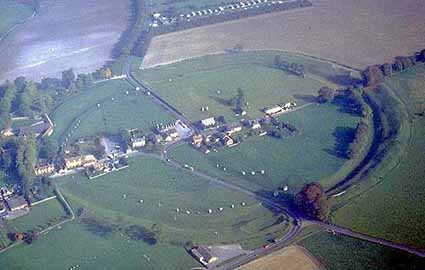![]()
![]()
vii. The Winged Serpent

Prehistoric Avebury, the megalithic stone complex in the southern county of Wiltshire in South-west England, is second only to Stonehenge in grandeur and popularity. Constructed c. 2600-2000 BC, it consists of a circular henge and ditch that appear uncannily like those making up Newark's Great Circle. Yet unlike its American counterpart, Avebury has a gigantic circle of standing stones inside the henge, with another pair of circles contained inside the larger one. Approaching the great circular earthwork from a distance of around 2.5 kilometres (1.5 miles) were once two giant avenues of stones, of which only fragments of one remain today (the Kennet Avenue). Aubrey Burl, a leading authority on megalithic structures in Britain, has outlined his belief that Avebury was the centre for a regional cult of the dead and rebirth.
|
Overhead photo of Avebury. Photo credit: Martin Gray. |
Avebury was surveyed during the eighteenth century by antiquarian William Stukeley, who saw the whole monument in terms of a winding serpent (the avenues) curling around a sun disk (the main henge and circles). For him it was a personification of Kneph, a Graeco-Egyptian creator god (also known as Chnoubis, or Khnum) which he acknowledged was linked in classical mysteries with the story of 'Cycnus', a character of legend personified in the sky as the Cygnus constellation. Yet this fact was forgotten, even when in the 1960s Professor Alexander Thom, famous for finding stellar and lunar alignments at hundreds of stone circles across Britain, established that the central axis of Avebury was aligned to the setting of the star Deneb in Cygnus. |
His contemporary Gerald Hawkins, author of the bestselling book STONEHENGE DECODED (1965), who famously used a computer to demonstrate that Stonehenge was used to calculate eclipses, doubted this, stating that the ancients would not have used such an insignificant star.
Yet what he did not know is that several other key megalithic sites in Britain are also aligned to Deneb, including a number of chambered monuments in the vicinity of Avebury. Was this a survival through from the Early Neolithic era, which had begun in Southeast Turkey some 7,000 years beforehand?
|
Adding to Avebury's suspected connections with the Cygnus constellation is the fact that the only carving to be seen on a standing stone there (Stone #25S in the Kennet Avenue) shows the head and neck of a swan (first identified by local earth mysteries writer John Wakefield). Nobody before had made the link between this stone and the swan. In the knowledge that the water-filled meadows of nearby Silbury Hill, as well as the Kennet river which runs alongside Avebury, once played host each winter to flocks of migrating whooper swans inbound from their breeding grounds in the Arctic, this had to relate in some way to Avebury's axial alignment towards the setting of Deneb. In the knowledge that Avebury has frequently been linked with the ancient British goddess called variously Bride, Brigid, Bridget, Breeshey and Brigantia, whose main totemic symbols are the swan and serpent, might she help us better define the precise nature of the site's link to Cygnus? |
Sue by Stone # 25S in the Kennet Avenue, Avebury. |
![]()
![]()

